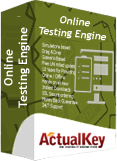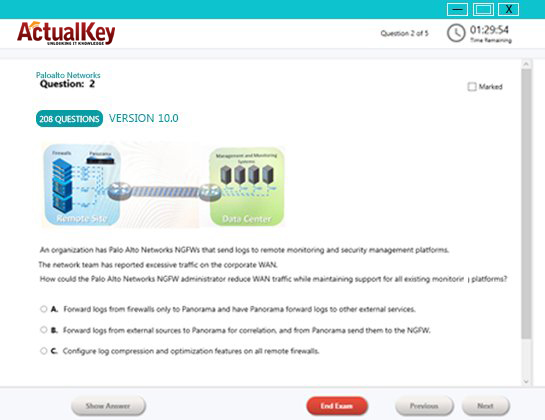Limited Time 30% Discount Offer Use Code - off30
Actualkey Prepration Latest 350-501 : Implementing and Operating Cisco Service Provider Network Core Technologies (350-501 SPCOR) Questions and Answers PDF's, Verified Answers via Experts - Pass Your Exam For Sure and instant Downloads - "Money Back Guarantee".
| Vendor | Cisco |
| Certification | Cisco Certified Specialist - Service Provider Core |
| Exam Code | 350-501 |
| Title | Implementing and Operating Cisco Service Provider Network Core Technologies (350-501 SPCOR) |
| No Of Questions | 452 |
| Last Updated | November 8,2024 |
| Product Type | Q & A with Explanation |
| Bundel Pack Included | PDF + Offline / Andriod Testing Engine and Simulator |
Implementing and Operating Cisco Service Provider Network Core Technologies
Duration: 120 minutes
Languages: English
Price: $400 USD, plus tax or use Cisco Learning Credits
Associated certifications
CCNP Service Provider
CCIE Service Provider
Cisco Certified Specialist - Service Provider Core
Exam overview
This exam tests your knowledge of implementing core service provider network technologies, including:
Core architecture
Services
Networking
Automation
Quality of services
Security
Network assurance
Implementing and Operating Cisco Service ProviderNetwork Core Technologies v1.0 (350-501)
Exam Description:
Implementing and Operating Cisco Service Provider Network Core Technologies v1.0 (SPCOR 350-501) is a 120-minute exam associated with the CCNP and CCIE Service Provider
Certifications. This exam tests a candidate's knowledge of implementing core service provider network technologies including core architecture, services, networking, automation, quality of services, security,
and network assurance. The course, Implementing and Operating Cisco Service Provider Network Core Technologies, helps candidates to prepare for this exam.
The following topics are general guidelines for the content likely to be included on the exam. However, other related topics may also appear on any specific delivery of the exam. To better reflect the contents
of the exam and for clarity purposes, the guidelines below may change at any time without notice.
15% 1.0 Architecture
1.1 Describe service provider architectures
1.1.a Core architectures (Metro Ethernet, MPLS, unified MPLS, SR)
1.1.b Transport technologies (Optical, xDSL, DOCSIS, TDM, and xPON)
1.1.c Mobility (packet core, RAN xhaul transport for 4G and 5G)
1.2 Describe Cisco network software architecture
1.2.a IOS
1.2.b IOS XE
1.2.c IOS XR
1.3 Describe service provider virtualization
1.3.a NFV infrastructure
1.3.b VNF workloads
1.3.c OpenStack
1.4 Describe QoS architecture
1.4.a MPLS QOS models (Pipe, Short Pipe, and Uniform)
1.4.b MPLS TE QoS (MAM, RDM, CBTS, PBTS, and DS-TE)
1.4.c DiffServ and IntServ QoS models
1.4.d Trust boundaries between enterprise and SP environments
1.4.e IPv6 flow label
1.5 Configure and verify control plan security
1.5.a Control plane protection techniques (LPTS and CoPP)
1.5.b BGP-TTL security and protocol authentication
1.5.c BGP prefix suppression
1.5.d LDP security (authentication and label allocation filtering)
1.5.e BGP sec
1.5.f BGP flowspec
1.6 Describe management plane security
1.6.a Traceback
1.6.b AAA and TACACS
1.6.c RestAPI security
1.6.d DdoS
1.7 Implement data plane security
1.7.a uRPF
1.7.b ACLs
1.7.c RTBH
30% 2.0 Networking
2.1 Implement IS-IS (IPv4 and IPv6)
2.1.a Route advertisement
2.1.b Area addressing
2.1.c Multitopology
2.1.d Metrics
2.2 Implement OSPF (v2 and v3)
2.2.a Neighbor adjacency
2.2.b Route advertisement
2.2.c Multiarea (addressing and types)
2.2.d Metrics
2.3 Describe BGP path selection algorithm
2.4 Implement BGP (v4 and v6 for IBGP and EBGP)
2.4.a Neighbors
2.4.b Prefix advertisement
2.4.c Address family
2.4.d Path selection
2.4.e Attributes
2.4.f Redistribution
2.5 Implement routing policy language and route maps (BGP, OSPF, IS-IS)
2.6 Troubleshoot routing protocols
2.6.a Neighbor adjacency (IS-IS, OSPF, BGP)
2.6.b Route advertisement (IS-IS, OSPF, BGP)
2.7 Describe IPv6 transition (NAT44, NAT64, 6RD, MAP, and DS Lite)
2.8 Implement high availability
2.8.a NSF / graceful restart
2.8.b NSR
2.8.c BFD
2.8.d Link aggregation
20% 3.0 MPLS and Segment Routing
3.1 Implement MPLS
3.1.a LDP sync
3.1.b LDP session protection
3.1.c LDP neighbors
3.1.d Unified MPLS
3.1.e MPLS OAM
3.2 Describe traffic engineering
3.2.a ISIS and OSPF extensions
3.2.b RSVP functionality
3.2.c FRR
3.3 Describe segment routing
3.3.a Segment types
3.3.b IGP control plane
3.3.c Segment routing traffic engineering
3.3.d TI-LFa
3.3.e PCE-PCC architectures
20% 4.0 Services
4.1 Describe VPN services
4.1.a EVPN
4.1.b Inter-AS VPN
4.1.c CSC
4.1.d mVPN
4.2 Configure L2VPN and Carrier Ethernet
4.2.a Ethernet services (E-Line, E-Tree, E-Access, E-LAN)
4.2.b IEEE 802.1ad, IEEE 802.1ah, and ITU G.8032
4.2.c Ethernet OAM
4.2.d VLAN tag manipulation
4.3 Configure L3VPN
4.3.a Intra-AS VPN
4.3.b Shared services (extranet and Internet)
4.4 Implement multicast services
4.4.a PIM (PIM-SM, PIM-SSM, and PIM-BIDIR)
4.4.b IGMP v1/v2/v3 and MLD
4.5 Implement QoS services
4.5.a Classification and marking
4.5.b Congestion avoidance, traffic policing, and shaping
15% 5.0 Automation and Assurance
5.1 Describe the programmable APIs used to include Cisco devices in network automation
5.2 Interpret an external script to configure a Cisco device using a REST API
5.3 Describe the role of Network Services Orchestration (NSO)
5.4 Describe the high-level principles and benefits of a data modeling language, such as YANG
5.5 Compare agent vs. agentless configuration management tools, such as Chef, Puppet, Ansible, and SaltStack
5.6 Describe data analytics and model-driven telemetry in service provider
5.7 Configure dial-in/out telemetry streams using gRPC
5.8 Configure and verify NetFlow/IPFIX
5.9 Configure and verify NETCONF and RESTCONF
5.10 Configure and verify SNMP (v2c/v3)
Sample Questions and Answers
QUESTION 1
Egress PE NAT is being used via a single centralized router to provide Internet access to L3VPN customers.
Which description of the NAT operation is true?
A. Users m different VRFs cannot share the same outside global IP address
B. The NAT table contains a field to identify the inside VRF of a translation
C. Multiple address pools are needed for the same L3VPN because each site has a separate NAT
D. The different L3VPNs using the Internet access must not have IP overlaps internally
Answer: B
QUESTION 2
How much must the MTU be increased when configuring the 802.1q VLAN tag?
A. 2 bytes
B. 4 bytes
C. 8 bytes
D. 12 bytes
Answer: B
QUESTION 3
Refer to the exhibit:
Export statistics received do not include the BGP next hop.
Which statement about the NetFlow export statistics is true?
A. Only the origin AS of the source router will be included in the export statistics.
B. Loopback 0 must be participating in BGP for it to be included in the export statistics.
C. The origin AS and the peer-as will be included in the export statistics.
D. To include the BGP next hop in the export statistics, those keywords must be included with the version 9 entry.
Answer: D
QUESTION 4
Refer to the exhibit:
Which three outcomes occur if the prefix list is added to the neighbor? (Choose three)
A. 192.168 0.0 is denied.
B. 192.168 0.0 is denied.
C. 192.168 0.0 is permitted
D. 192.168.0.0 is denied
E. 192.168 0.0 is permitted
F. 192.168 0.0 is permitted
Answer: CDF
QUESTION 5
Which statement about segment routing prefix segments is true?
A. It is linked to a prefix SID that is globally unique within segment routing domain.
B. It is the longest path to a node.
C. It is linked to an adjacency SID that is globally unique within the router.
D. It requires using EIGRP to operate.
Answer: A
QUESTION 6
DRAG DROP
Drag and drop the functions from the left onto the correct Path Computation Element Protocol roles
on the right
Answer:
Explanation:
Path Computation Element (Calculates paths through the network, keeps TE topology database
information, sends path status updates)
Path computation Client (sends path calculation request, sends path creation request)
Path Computation Element (PCE)
Represents a software module (which can be a component or application) that enables the router to
compute paths applying a set of constraints between any pair of nodes within the routers TE
topology database. PCEs are discovered through IGP.
Path Computation Client (PCC)
Represents a software module running on a router that is capable of sending and receiving path
computation requests and responses to and from PCEs. The PCC is typically an LSR (Label Switching
Router).
https://www.cisco.com/c/en/us/td/docs/routers/crs/software/crs_r5-3/mpls/configuration/guide/bmplscg53x-
crs/b-mpls-cg53x-crs_chapter_0110.html#con_1279822
QUESTION 7
You are creating new Cisco MPLS TE tunnels. Which type of RSVP message does the headend router send to reserve bandwidth on the path to the tunnels router?
A. error
B. reservation
C. path
D. tear
Answer: C
QUESTION 8
An engineer is setting up overlapping VPNs to allow VRF ABC and XYZ to communicate with VRF
CENTRAL but wants to make sure that VRF ABC and XYZ cannot communicate. Which configuration accomplishes these objectives?
A. Option A
B. Option B
C. Option C
D. Option D
Answer: C
QUESTION 9
In an MPLS network, which protocol can be used to distribute a Segment Prefix?
A. OSPF
B. LDP
C. RSVP-TE
D. EIGRP
Answer: A
QUESTION 10
DRAG DROP
Drag and drop the NAT64 descriptions from the left onto the correct NAT64 types on the right.
Answer:
Explanation:
Stateful (It has 1: N translation, It uses address overloading, It conservers IPv4 addresses)
Stateless (It is limited on the number of endpoints, It mandates IPv4-translatable IPv6 address allocation)
QUESTION 11
Which statement about Network Services Orchestrator (NSO) is true?
A. It is used only in service provider environments
B. It can be used only with XML coding
C. It uses YANG modeling language to automate devices
D. It must use SDN as an overlay for addressing
Answer: C
QUESTION 12
Which task must be performed first to Implement BFD in an IS-IS environment?
A. Disable Cisco Express Forward.ng on all interfaces running routing protocols other than IS-IS
B. Configure BFD under the IS-IS process
C. Configure all ISIS routers as Level 2 devices
D. Configure BFD in an interface configuration mode
Answer: D
QUESTION 13
An engineer working for telecommunication company with an employee id: 3715 15 021 needs to
secure the LAN network using a prefix list Which best practice should the engineer follow when he implements a prefix list?
A. An engineer must use non sequential sequence numbers in the prefix list so that he can insert additional entries later.
B. The final entry in a prefix list must be
C. An engineer must identity the prefix list with a number only
D. An engineer must include only the prefixes for which he needs to log activity.
Answer: A
I Got My Success Due To Actualkey 350-501 Bundle Pack Actualkey experts I got passed in the 350-501 exam without any worries at all, these exam material products gave me the reason to relax.
Budi Saptarmat
Yahoo! Got Successfully Through The 350-501 Exam Passing Exam is not a easy thanks to Acutalkey.com for providing me actual 350-501 Implementing and Operating Cisco Service Provider Network Core Technologies (350-501 SPCOR) training with there included the Offline and Android simulators helps me success
Melinda
350-501 Exam Best Preparation I have been preparing for 350-501 Implementing and Operating Cisco Service Provider Network Core Technologies (350-501 SPCOR), I was not sure that I'll be able to pass because of the fact that I am not a good student however;Actualkey.com provided me best and simple exam training pdf's and I passed. I now recommend everyone
Antonio Moreno
Actualkey.com 350-501 Offline Simulator is Best My choice to select Actualkey.com and go for the preparation 350-501 Implementing and Operating Cisco Service Provider Network Core Technologies (350-501 SPCOR), because I got the short way with the easy way
Liliane Meichner
Actualkey.com 350-501 Exam PDF"s passed with in a week 350-501 exam pdf's that's amazing
James Wilson
Cisco - RELATED EXAMS
Implementing Cisco Unified Communications Manager Part 2 (CIPT2 v6.0)
Questions: 174 | May 8, 2024
Implementing Cisco Security Monitoring, Analysis andResponse System
Questions: 49 | May 8, 2024
Cisco Wide Area Application Services for System Engineers exam
Questions: 60 | August 1, 2024
Cisco Data Center Networking Infrastructure Solutions design
Questions: 120 | August 1, 2024
Implementing Cisco Unified Wireless Networking Essentials (IUWNE)
Questions: 203 | July 1, 2024
Associated Certifications: Cisco Storage Networking Support Specialist
Questions: 74 | August 1, 2024
Implementing Cisco Security Monitoring, Analysis, and Response System
Questions: 67 | August 1, 2024
Wide Area Application Services for System Engineers (WAASSE)
Questions: 90 | January 5, 2024
Implementing Advanced Cisco Unified Wireless Security (IAUWS)
Questions: 85 | January 7, 2024
Troubleshooting and Maintaining Cisco IP Switched Networks (TSHOOT)
Questions: 72 | January 7, 2024
Implementing Cisco Unified Communications Voice over IP and QoS v8.0 (CVOICE v8.0)
Questions: 257 | July 1, 2024
Securing Networks with Cisco Routers and Switches (SECURE) v1.0
Questions: 136 | July 1, 2024
Implementing Cisco Unified CommunicationsManager, Part 2 v8.0 (CIPT2 v8.0)
Questions: 215 | July 1, 2024
Introducing Cisco Voice and Unified Communications Administration v8.0
Questions: 300 | May 8, 2024
Integrating Cisco Unified Communications Applications v8.0 (CAPPS v8.0)
Questions: 203 | May 8, 2024
Operational Foundations for Cisco Service Provider Core Networks
Questions: 91 | May 8, 2024
Maintaining Cisco Service Provider VPNs and MPLS Networks (MSPVM)
Questions: 89 | May 8, 2024
Cisco Data Center Unified Computing Support Specialist Qualifier Exam (DCUCI Qualifier Exam)
Questions: 65 | May 8, 2024
Cisco Data Center Unified Computing Design Specialist Qualifier Exam
Questions: 62 | May 8, 2024
Designing for Cisco Internetwork Solutions Exam (DESGN) v2.1
Questions: 241 | October 1, 2024
Maintaining Cisco Service Provider Routing Protocols (MSPRP)
Questions: 70 | October 1, 2024
Maintaining Cisco Service Provider Quality of Service (MSPQS)
Questions: 91 | October 1, 2024
PSACAS Advanced Collaboration Architecture Sales Specialist Exam
Questions: 56 | May 8, 2024
PSACASE Advanced Collaboration Architecture System Engineer Exam
Questions: 64 | May 8, 2024
PSACAFE Advanced Collaboration Architecture Field Engineer Exam
Questions: 50 | August 1, 2024
Cisco IronPort Certified Security Professional (CICSP) Web Security 7.0
Questions: 66 | August 1, 2024
Implementing Cisco TelePresence Video Networking Solutions Exam
Questions: 57 | August 1, 2024
Advanced Borderless Network Architecture Systems Engineer Exam
Questions: 60 | August 1, 2024
Cisco Substation Automation System and Field Engineer Knowledge Verification
Questions: 58 | May 8, 2024
Authorized Connected Grid Account Manager Knowledge Verification
Questions: 23 | August 1, 2024
Cisco Data Center Unified Computing Systems Implementation (DCUCI)
Questions: 78 | May 8, 2024
Introduction to 802.1X Operations for Cisco Security Professionals Exam (S802DT1X)
Questions: 69 | May 8, 2024
Introducing Cisco Identity Services Engine for System Engineer Exam (PAISESE)
Questions: 34 | May 8, 2024
PASCERAM - Cisco SaaS Conferencing and EIM Resale ATP for the AM Exam
Questions: 35 | May 8, 2024
Cisco SP Video Wireline & Cable Headend Design Specialist for SE
Questions: 33 | May 8, 2024
PASCERSE - Cisco SaaS Conferencing and EIM Resale ATP for the SE Exam
Questions: 56 | May 8, 2024
Building Cisco Service Provider Next-Generation Networks, Part 2
Questions: 126 | May 8, 2024
Building Cisco Service Provider Next-Generation Networks, Part 1 Exam
Questions: 257 | October 25, 2024
Implementing Advanced Cisco Unified Wireless Security (IAUWS) v2.0
Questions: 206 | May 8, 2024
Deploying Cisco Service Provider Network Routing (SPROUTE)
Questions: 174 | January 12, 2024
Implementing Cisco Service Provider Next-Generation Core Network Services (SPCORE)
Questions: 184 | January 12, 2024
Implementing Cisco Service Provider Next-Generation Edge Network Services (SPEDGE) Exam
Questions: 185 | January 12, 2024
Implementing and Maintaining Cisco Technologies Using IOS XR - (IMTXR)
Questions: 77 | January 12, 2024
Designing and Implementing Cisco Unified Communications on Unified Computing Systems - DIUCUCS
Questions: 60 | January 12, 2024
Implementing and Configuring Cisco Identity Service Engine - SISE
Questions: 49 | July 1, 2024
PASCERFE - Cisco SaaS Conferencing and EIM Resale ATP for the FE Exam
Questions: 53 | July 1, 2024
Advanced Borderless Network Architecture Field Engineer Exam
Questions: 86 | January 15, 2024
Advanced Borderless Network Architecture Systems Engineer Exam (700-303)
Questions: 156 | January 15, 2024
Cisco Implementing Cisco Secure Mobility Solutions Exam (SIMOS)
Questions: 543 | May 17, 2024
Unified Communications Contact Center Express Implementation - UCCX
Questions: 50 | January 15, 2024
Performing Business-Focused Transformative Architecture Engagements
Questions: 67 | January 17, 2024
Configuring Cisco UCS and Cisco Catalyst 3000 for Vblock Series 100
Questions: 45 | January 17, 2024
Cisco Application Centric Infrastructure for System Engineers
Questions: 58 | January 17, 2024
Implementing Cisco Service Provider Mobile Unlicensed Small Cell Solutions
Questions: 51 | January 17, 2024
Securing Cisco Networks with Sourcefire Intrusion Prevention System
Questions: 59 | January 17, 2024
Implementing Cisco Service Provider Mobility UMTS Networks (SPUMTS)
Questions: 70 | January 17, 2024
Implementing Cisco Service Provider Mobility CDMA Networks (SPCDMA)
Questions: 70 | January 17, 2024
Implementing Cisco Service Provider Mobility LTE Networks (SPLTE)
Questions: 70 | January 17, 2024
Integrating Business Applications with Network Programmability (NPIBA)
Questions: 66 | January 17, 2024
Managing Industrial Networks with Cisco Networking Technologies (IMINS)
Questions: 64 | January 17, 2024
Designing with Cisco Network Programmability for ACI (NPDESACI)
Questions: 60 | January 17, 2024
Implementing with Cisco Network Programmability for ACI (NPENGACI)
Questions: 60 | January 17, 2024
Cisco Application Centric Infrastructure for Account Managers
Questions: 41 | January 17, 2024
Executing Cisco Advanced Business Value Analysis and Design Techniques
Questions: 60 | July 1, 2024
Troubleshooting and Maintaining Cisco IP Networks (TSHOOT)
Questions: 254/24Case Study | January 18, 2024
Cisco Application Centric Infrastructure for Field Engineers Exam
Questions: 50 | September 16, 2024
Implementing and Supporting Cisco Unified Contact Center Enterprise Exam
Questions: 95 | September 16, 2024
Executing Cisco Advanced Business Value Analysis and Design Techniques
Questions: 182 | September 16, 2024
Applying Cisco Specialized Business Value Analysis Skills
Questions: 173 | September 16, 2024
Cisco Implementing Cisco Wireless Network Fundamentals Exam
Questions: 509 | September 16, 2024
Managing Industrial Networks for Manufacturing with Cisco Technologies
Questions: 87 | September 16, 2024
Cisco Implementing and Troubleshooting the Cisco Cloud Infrastructure Exam
Questions: 132 | September 16, 2024
Building the Cisco Cloud with Application Centric Infrastructure
Questions: 60 | September 16, 2024
Cisco Leading Virtual Classroom Instruction - Written Exam
Questions: coming soon | September 16, 2024
Cisco Leading Virtual Classroom Instruction - Practical Exam
Questions: coming soon | September 16, 2024
Integrating Business Applications with Network Programmability
Questions: coming soon | January 19, 2024
Cisco Implementing Cisco Data Center Virtualization and Automation Exam
Questions: 167 | January 21, 2024
Cisco Midsize Collaboration Solutions for Account Managers (MCAM)
Questions: 30 | April 11, 2024
Cisco Data Center Unified Computing Infrastructure Design (DCICUC)
Questions: 40 | January 21, 2024
Cisco Enterprise Networks SDA, SDWAN and ISE Exam for System Engineers
Questions: 35 | January 21, 2024
Automating and Programming Cisco Security Solutions (SAUTO) Exam
Questions: 332 | May 9, 2024
Implementing and Operating Cisco Enterprise Network Core Technologies (ENCOR) Exam
Questions: 1172 | March 14, 2025
Implementing and Operating Cisco Data Center Core Technologies (DCCOR) Exam
Questions: 633 | May 10, 2024
Implementing Cisco Enterprise Advanced Routing and Services (ENARSI) Exam
Questions: 598 | March 14, 2025
Understanding Cisco Cybersecurity Operations Fundamentals (CBROPS) Exam
Questions: 430 | May 9, 2024
Designing Cisco Enterprise Wireless Networks (300-425 ENWLSD) Exam
Questions: 196 | November 8, 2024
Implementing Cisco Enterprise Wireless Networks (300-430 ENWLSI) Exam
Questions: 216 | November 8, 2024
Automating and Programming Cisco Enterprise Solutions (ENAUTO 300-435) Exam
Questions: 125 | November 8, 2024
Designing Cisco Data Center Infrastructure (300-610 DCID) Exam
Questions: 204 | November 8, 2024
Troubleshooting Cisco Data Center Infrastructure (300-615 DCIT) Exam
Questions: 517 | November 8, 2024
Implementing Cisco Application Centric Infrastructure (300-620 DCACI) Exam
Questions: 192 | November 8, 2024
Implementing Cisco Storage Area Networking (300-625 DCSAN) Exam
Questions: 60 | November 8, 2024
Securing Networks with Cisco Firepower (300-710 SNCF) Exam
Questions: 325 | November 8, 2024
Implementing and Configuring Cisco Identity Services Engine (300-715 SISE) Exam
Questions: 244 | November 8, 2024
Securing Email with Cisco Email Security Appliance (300-720 SESA) Exam
Questions: 147 | November 8, 2024
Securing the Web with Cisco Web Security Appliance (300-725 SWSA) Exam
Questions: 60 | November 8, 2024
Implementing Secure Solutions with Virtual Private Networks (SVPN 300-730) Exam
Questions: 175 | November 8, 2024
Implementing Cisco Collaboration Applications (300-810 CLICA) Exam
Questions: 213 | November 8, 2024
Implementing Cisco Advanced Call Control and Mobility Services (300-815 CLACCM) Exam
Questions: 174 | November 8, 2024
Implementing Cisco Collaboration Cloud and Edge Solutions (300-820 CLCEI)
Questions: 93 | November 8, 2024
Implementing DevOps Solutions and Practices using Cisco Platforms (300-910 DEVOPS) Exam
Questions: 130 | November 8, 2024
Developing Applications for Cisco Webex and Webex Devices (300-920 DEVWBX) Exam
Questions: 60 | November 8, 2024
Implementing and Operating Cisco Service Provider Network Core Technologies (350-501 SPCOR)
Questions: 452 | November 8, 2024
Implementing and Operating Cisco Security Core Technologies (SCOR 350-701) Exam
Questions: 633 | November 8, 2024
Implementing Cisco Collaboration Core Technologies (350-801 CLCOR) Exam
Questions: 273 | November 8, 2024
Developing Applications using Cisco Core Platforms and APIs v1.0 (DEVCOR 350-901) Exam
Questions: 363 | November 8, 2024
Designing Cisco Unified Contact Center Enterprise (UCCED) Exam
Questions: 93 | November 8, 2024
Implementing Cisco Application Centric Infrastructure - Advanced (600-660 - 300-630 DCACIA)
Questions: 76 | November 8, 2024
Supporting Cisco Routing and Switching Network Devices v3.0 - RSTECH Exam
Questions: 72 | November 8, 2024
Cisco Security Architecture for System Engineers (ASASE) Exam
Questions: 92 | November 8, 2024
Implementing Cisco Service Provider Advanced Routing Solutions (SPRI) Exam
Questions: 214 | November 8, 2024
Implementing Cisco Service Provider VPN Services (300-515 SPVI) Exam
Questions: 71 | November 8, 2024
Developing Solutions Using Cisco IoT and Edge Platforms (DEVIOT) Exam
Questions: 60 | November 8, 2024
Conducting Forensic Analysis and Incident Response Using Cisco CyberOps Technologies (CBRFIR) Exam
Questions: 59 | May 10, 2024
Performing CyberOps Using Core Security Technologies (CBRCOR) Exam
Questions: 139 | May 10, 2024
Implementing Cisco Collaboration Conferencing (CLCNF) Exam
Questions: 60 | September 16, 2024
Implementing Cisco SD-WAN Solutions (ENSDWI) Exam Corresponding Certification: CCNP Enterprise
Questions: 163 | September 16, 2024
Cisco Data Center Unified Computing Infrastructure Troubleshooting Exam
Questions: 40 | September 16, 2024
ENCOR Implementing and Operating Cisco Enterprise Network Core Technologies
Questions: 747 | May 10, 2024
Cisco Advanced Administration and Reporting of Contact Center Enterprise Exam
Questions: 60 | July 1, 2024
Cisco Certified Support Technician (CCST) Networking Exam
Questions: 40 | November 7, 2024
Cisco Collaboration SaaS Authorization for PreSales Engineer Exam
Questions: 60 | September 4, 2024
Exams code, certifications, vendor or keywords
![]()
Copyright © 2009 - 2025 Actualkey. All rights reserved.





